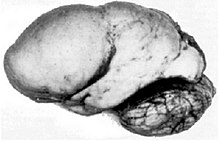
Back انعدام تلافيف الدماغ Arabic Lissencefàlia Catalan Lissenzephalie German Lisencefalia Spanish Lissenkefalia Finnish Lissencéphalie French ליסאנצפליה HE Lissencefalia Italian Lissencefalie Dutch Bezzakrętowość Polish
This article needs more reliable medical references for verification or relies too heavily on primary sources. (June 2022) |  |
| Lissencephaly | |
|---|---|
 | |
| Lissencephalic brain of a human, lacking surface convolutions (gyrification) | |
| Specialty | Medical genetics, neurology |
| Causes | Absence of gyrification |
| Treatment | See below |
| Prognosis | Usually die young; see below for details |
Lissencephaly (/ˌlɪs.ɛnˈsɛf.əl.i/, meaning 'smooth brain')[1] is a set of rare brain disorders whereby the whole or parts of the surface of the brain appear smooth.[2] It is caused by defective neuronal migration during the 12th to 24th weeks of gestation resulting in a lack of development of brain folds (gyri) and grooves (sulci).[3] It is a form of cephalic disorder. Terms such as agyria (no gyri) and pachygyria (broad gyri) are used to describe the appearance of the surface of the brain.
Children with lissencephaly generally have significant developmental delays, but these vary greatly from child to child depending on the degree of brain malformation and seizure control. Life expectancy can be shortened, generally due to respiratory problems.
- ^ "Lissencephaly Information Page". National Institute of Neurological Disorders and Stroke. Retrieved 2019-10-31.
- ^ Toy, Eugene; Simpson, Ericka; Tinter, Ron (2013). Case Files. Neurology (2nd ed.). McGraw Hill. p. 421. ISBN 978-0-07-176170-3.
- ^ Dobyns WB (1987). "Developmental aspects of lissencephaly and the lissencephaly syndromes". Birth Defects Original Article Series. 23 (1): 225–41. PMID 3472611.
© MMXXIII Rich X Search. We shall prevail. All rights reserved. Rich X Search